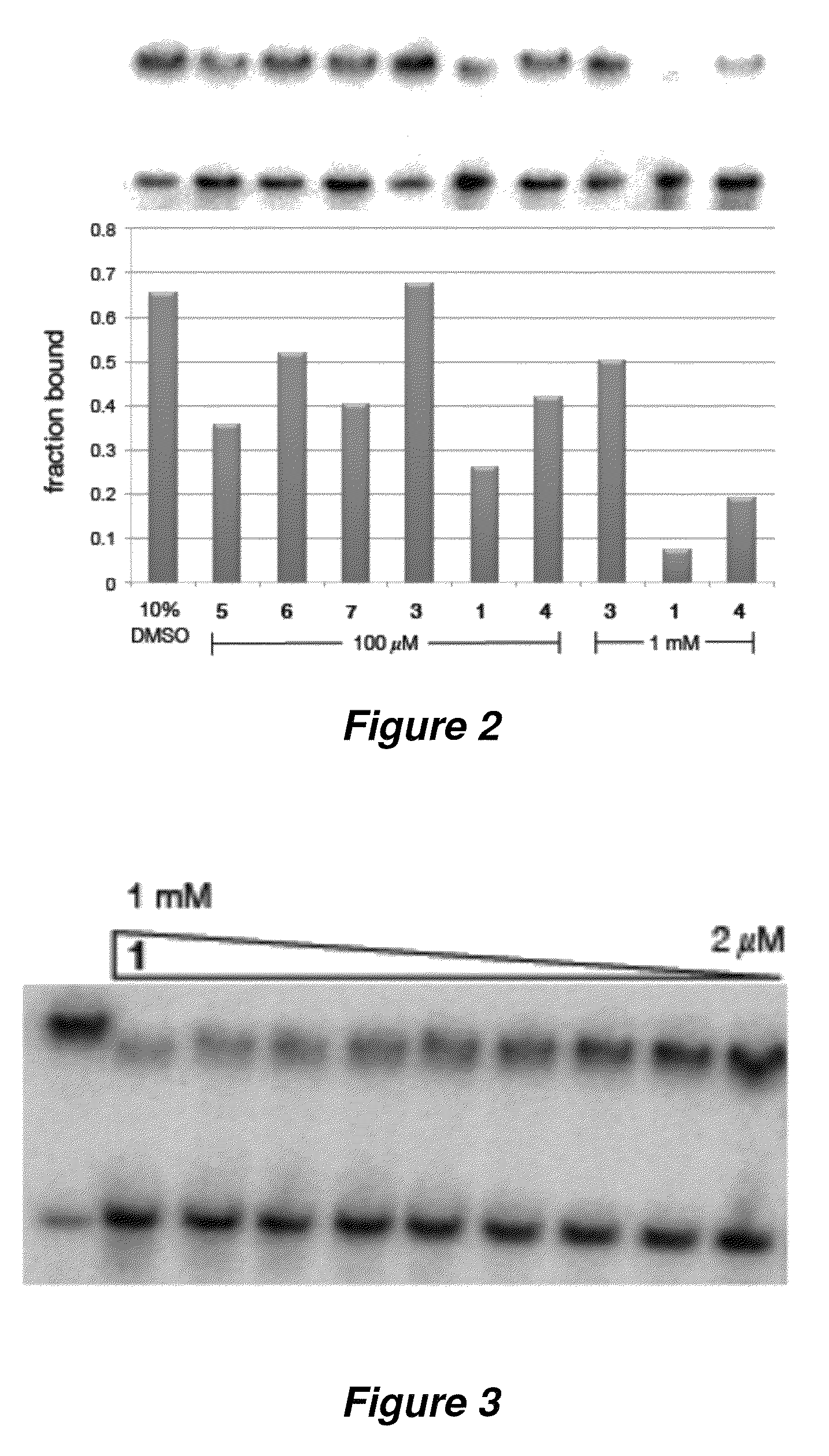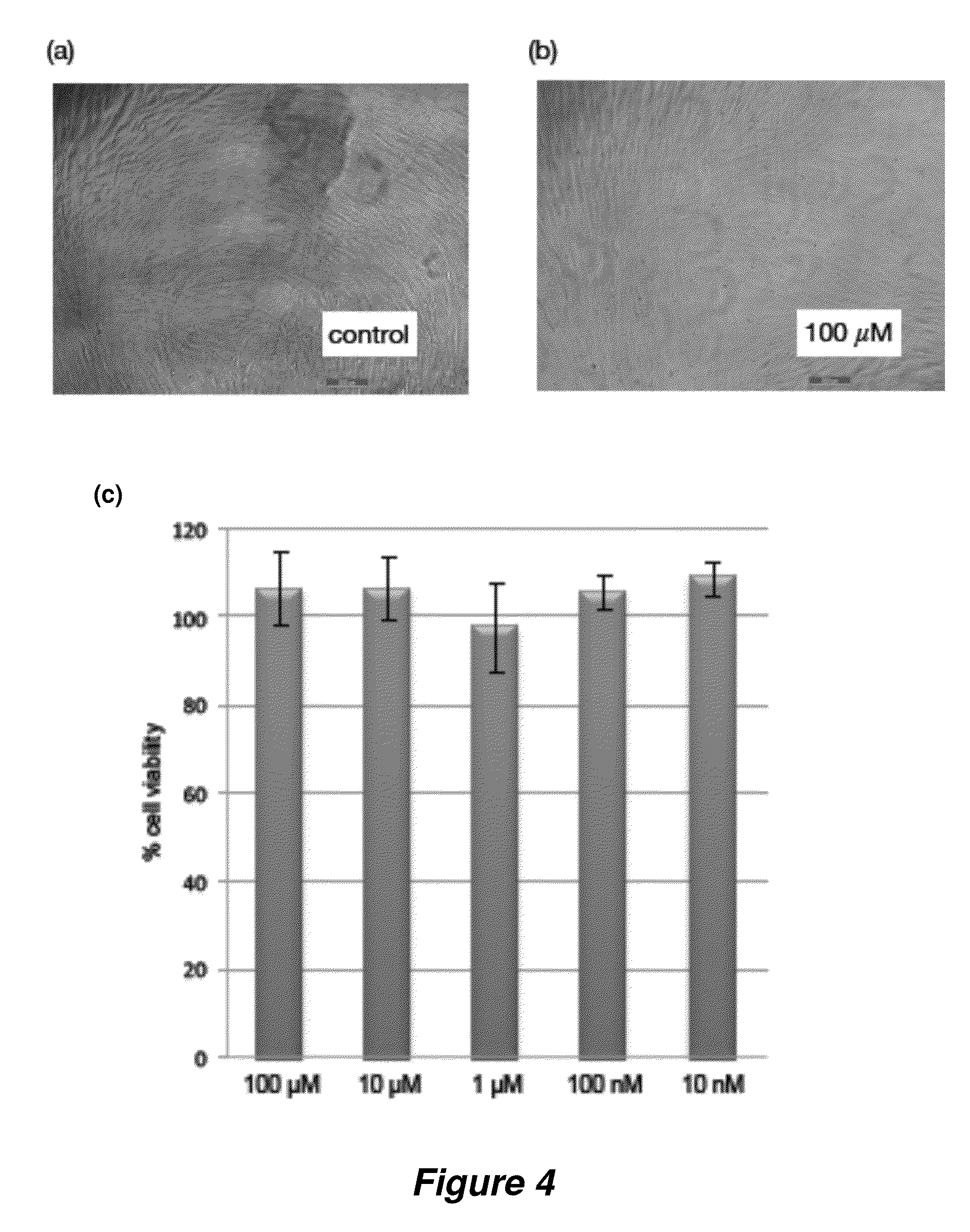Therapeutic methods and agents for treating myotonic dystrophy
a technology of myotonic dystrophy and therapeutic methods, applied in the direction of drug compositions, dispersed delivery, peptides, etc., can solve the problems of abnormal glucose response, cardiac conduction defect, hypersomnia, etc., and achieve low toxicity, less effective, high selectivity and efficacy
- Summary
- Abstract
- Description
- Claims
- Application Information
AI Technical Summary
Benefits of technology
Problems solved by technology
Method used
Image
Examples
example 1
Preparation of Ligand 1
[0148]Ligand 1 can be prepared as illustrated in the following schemes.
[0149]
[0150]The product can be isolated as a free base (ligand 1) (N1,N4-bis(4-((4,6-diamino-1,3,5-triazin-2-yl)amino)butyl)terephthalimidamide) or as a bis-HCl salt (2).
example 2
Preparation of Ligands A
[0151]Ligands A can be prepared as illustrated in the following schemes. For example, compounds of Formula I can be prepared by exposing 6-chloro-1,3,4-triazine-2,4-diamine to a linker compound having a structure according to NH2-L-NH2, wherein L is a linker as described for Formula I. The resulting compound, for example, the triazine having an amine-terminating linker as shown in the scheme below, can then be conjugated to a bis-alkyl or bis-aryl terephthalimidate.
[0152]
where n is 1 to about 12.
[0153]Other dialkylamine linkers can be used as described above. The product can then be conjugated with an optionally substituted dialkyl or diaryl terephthalimidate, as illustrated below, where R is alkyl or aryl, R1 is a substituent as described herein, and m is 0, 1, 2, 3 or 4.
[0154]
where n is 1 to about 12.
[0155]The product can be isolated as a free base or as a bis- or tetra-salt, as appropriate.
example 3
Pharmaceutical Dosage Forms
[0156]The following formulations illustrate representative pharmaceutical dosage forms that may be used for the therapeutic or prophylactic administration of a compound of a formula described herein, a compound specifically disclosed herein, or a pharmaceutically acceptable salt or solvate thereof (hereinafter referred to as ‘Compound X’):
[0157]
(i) Tablet 1mg / tablet‘Compound X’100.0Lactose77.5Povidone15.0Croscarmellose sodium12.0Microcrystalline cellulose92.5Magnesium stearate3.0300.0
[0158]
(ii) Tablet 2mg / tablet‘Compound X’20.0Microcrystalline cellulose410.0Starch50.0Sodium starch glycolate15.0Magnesium stearate5.0500.0
[0159]
(iii) Capsulemg / capsule‘Compound X’10.0Colloidal silicon dioxide1.5Lactose465.5Pregelatinized starch120.0Magnesium stearate3.0600.0
[0160]
(iv) Injection 1 (1 mg / mL)mg / mL‘Compound X’ (free acid form)1.0Dibasic sodium phosphate12.0 Monobasic sodium phosphate0.7Sodium chloride4.51.0N Sodium hydroxide solutionq.s.(pH adjustment to 7.0-7.5)W...
PUM
 Login to View More
Login to View More Abstract
Description
Claims
Application Information
 Login to View More
Login to View More - R&D
- Intellectual Property
- Life Sciences
- Materials
- Tech Scout
- Unparalleled Data Quality
- Higher Quality Content
- 60% Fewer Hallucinations
Browse by: Latest US Patents, China's latest patents, Technical Efficacy Thesaurus, Application Domain, Technology Topic, Popular Technical Reports.
© 2025 PatSnap. All rights reserved.Legal|Privacy policy|Modern Slavery Act Transparency Statement|Sitemap|About US| Contact US: help@patsnap.com



